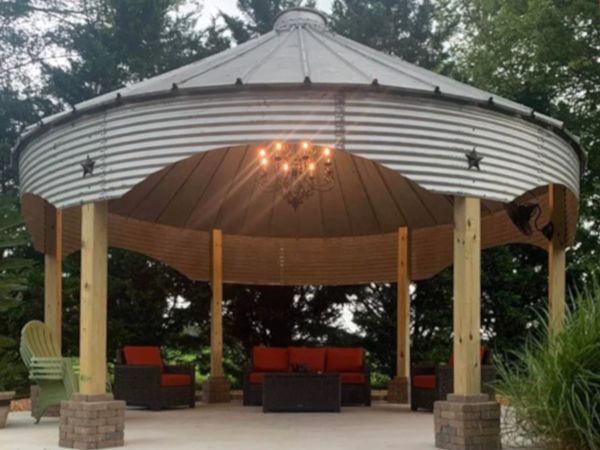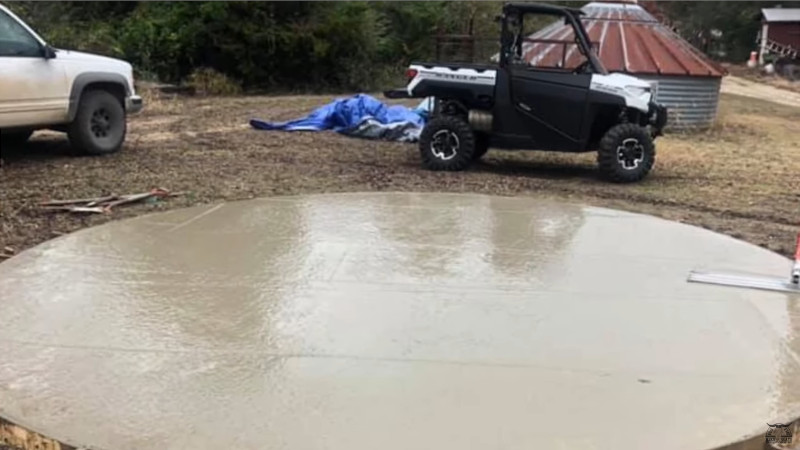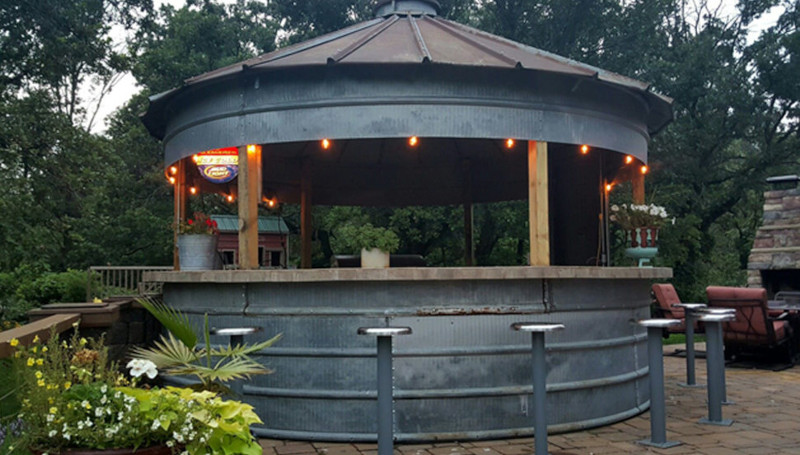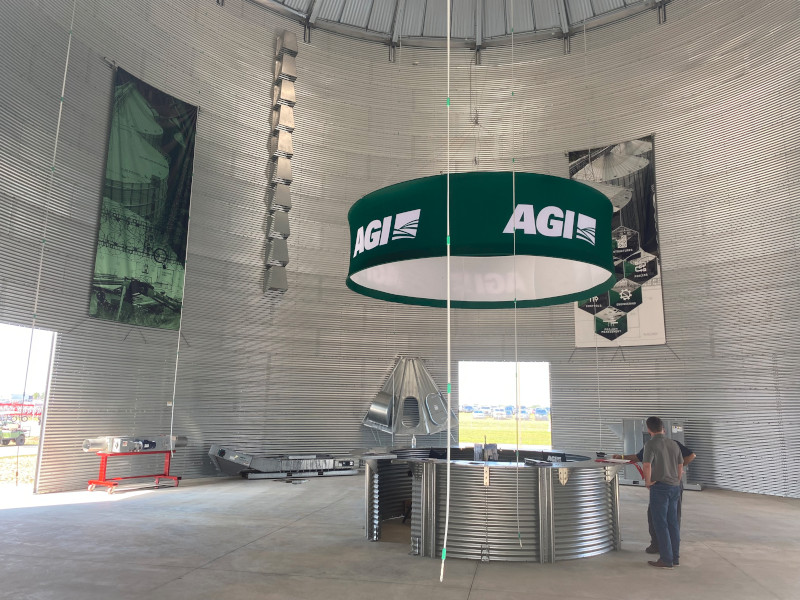Grain Bin Gazebos - An Attractive And Cost-Effective DIY Outdoor Addition
Oct. 3, 2021
DIY grain bin gazebos are a popular growing trend - learn how you can build your own for less than you would imagine.

When you travel along a highway surrounded by farmland, it is common to see the landscape sprinkled with round, beautiful steel structures known as grain bins. According to data presented in the CDC's Farm Safety Survey, about 230,000 farms in the United States use about 770,000 grain bins.
Converting grain bins into fun recreational gazebos is a growing trend among homeowners and farmers. Grain bin gazebos can be used to create outdoor patios, covered swimming pools, outdoor kitchens or barbeques, jacuzzi enclosures, and more. Some people have even made grain bin homes. The creative possibilities are endless.
Construction Costs & Materials
The construction costs to create a grain bin gazebo are probably lower than you would anticipate. At the low end, you can construct a grain bin gazebo for under $1,000 if you are able to get the grain bin for free and can borrow equipment to lift it. The primary items needed to create a grain bin gazebo include:
- Used Grain Bin ($0 to $10,000): Often, an old grain bin can be acquired for free or next to nothing if a farmer has decided to upgrade or replace it. You will want to select a grain bin that is safe (has not collapsed, and the structural support is intact). You will only use the grain bin roof and about 12-36" of the top wall, so it does not matter if the area below that is corroded or damaged.
- Concrete ($0 to $300): Although it is not necessary, most outdoor grain bin gazebo applications typically use a concrete base. You can also use a gravel or dirt foundation. Either way, you should make sure that your support beams are installed on a safe and sturdy base.
- Support Beams ($100 to $500): Your grain bin gazebo will require support beams to hold the gazebo roof in place. Many people use steel beams; however, you can also use sturdy wood poles or beams.
- Crane Rental ($300 to $3,000): You will likely need some sort of equipment to help you lift the gazebo room up while you install the support beams.
If you want a grain bin and do not want to hassle with the DIY work, you can always buy prefabricated grain bin gazebos from various companies, including Sioux Steel and Leslein Sales (Equipment Radar is not affiliated with or endorsed by these companies).
How To Build A Grain Bin Gazebo
Before you start construction, you should make a plan. Think about the design that you want, as well as where you want to put your gazebo. You should call to have your utilities marked in your yard before you start digging - this is important, so you avoid cutting lines or injuring yourself.
If you plan on adding a swimming pool, outdoor kitchen or another feature that requires electricity or plumbing, you should contact a qualified electrician or plumber to advise you on the best way to run connections to your outdoor grain bin gazebo. Often it is better to run connections the area before the foundation is poured.
All images of construction below are from the YouTube video by Bois D’ Arc Kiko Goats
1. Size & Cut Your Grain Bin
Determine how much of the grain bin side wall you want to keep on your gazebo. Most gazebos keep between 12-36" of the wall. You should leave enough space to attach support beams to it.
You can keep parts of the remaining wall for other uses, such as a bottom wall, as seen in the video.
2. Prepare foundation
Clear the area of debris and make sure you have marked the area for utilities. Then you should level the ground either by hand or with a machine such as a skid steer or mini excavator. Then you should pour your concrete base (or prepare any other base you want). If you pour concrete, you will have to wait until the concrete is finished setting.

3. Lift Grain Bin & Install Support Beams
Once your base is ready, you will need to lift your grain bin into place. The easiest way to do this is to rent a crane and hoist it up in the air. This job will require at least two people to perform it safely.


4. Verify Structural Support
Check the structural strength of your grain bin gazebo and support beams. Your bin should not wobble or move. All support beams should be level and perpendicular to the ground.

5. Decorate Interior
Once your grain bin is set up, you can get to work decorating the interior. You can view some design inspirations below.
Design Inspiration
The images below are meant to serve as design inspiration, and show you that the possibilities are endless.
Zach King on Pinterest has a great collection of grain bin gazebo designs. (Equipment Radar is not affiliated with or endorsed by Zach King / HingedBins).
The images below are from SiouxSteel.com (link above).





Safety & Items To Consider
As with any project, you should always follow safety precautions to ensure the safety of everyone involved in the construction as well as those who use the grain bin gazebo later.
If your grain bin gazebo has electricity or plumbing, make sure that a qualified professional does the work. Improperly configured electrical lines and plumbing can be dangerous.
Make sure you inspect the structural strength of the roof and support beams. The support beams should be anchored to the ground (bolted onto a cement base, or buried in a cement base) so they cannot move or wobble.
Consider the weather patterns for your area. It might not be windy now, but it could become very windy later. Grain bin gazebos are similar to an open umbrella - gusts of wind can lift the grain bin roof. You should consider adding air outlets along the roof to prevent wind build-up.
Grain Bin Industry
Grain bins are typically used to store dry corn, soybeans, barley, oats, etc before they are transported to buyers. Grain bins are typically wide and cylindrical, with a peaked roof to keep the contents dry. Typically grain bin housing is corrugated or smooth steel metal. Grain bins have openings to promote ventilation, and many include temperature systems, cushion boxes, flow valves and augers.
Farms large and small use grain bins. Farmers often need a safe place to store grain after harvesting to prevent mold, mildew and unwanted pests from spoiling the grains. Grain bins are a cost-effective way to safeguard grains.
Grain bins often have a useful life of 50 years or more. The housing is typically made from galvanized steel, which can take several decades to fade or rust. Usually, farmers will upgrade or replace their grain bins to increase capacity. Over time grain bins can experience wear and tear that weakens the overall structure and increases safety risks.
Large Grain Bins At Farm Progress Show



Source: Equipment Radar



